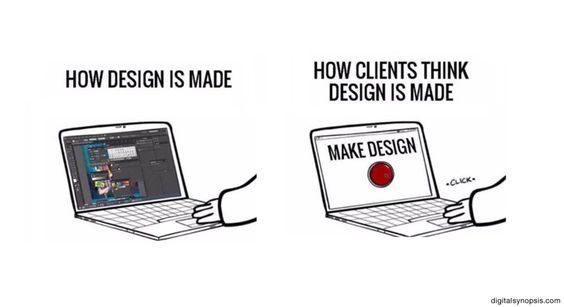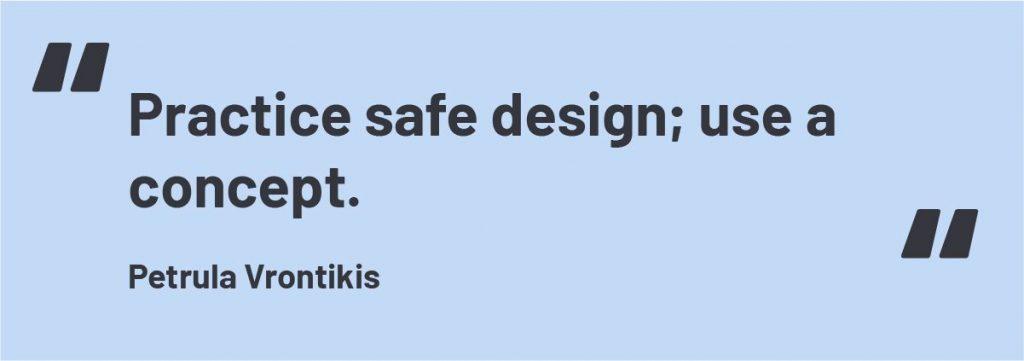What Do Graphic Designers Do on a Daily Basis
Get a brief overview of the graphic designer 's process to help you work better with freelancers and employees!
I met up with a freelancer friend recently and she told me that the single most frustrating part of her job was working with clients that don't understand what a graphic designer 's job looks like on a daily basis.
No, it's not just " drawing ".

If you're looking into finding a freelancer to work with , read on to find out what a freelance designer's typical day looks like and how you can make the most out of this professional relationship.
1. Making A Daily Plan
Unlike graphic design services where project managers assign daily tasks, freelancers have to self-manage according to their client roster , which means that their work schedule is always subject to last-minute adaptations.
A quality freelancer will always start the day off by checking the tasks they have planned and making a game plan.
Using project management software like Gruup, Asana, Monday or Trello can be a major advantage as it allows external collaborators (such as clients or other freelancers) to keep an eye on the project.
2. Reporting & ETA
Be it a freelancer or an agency worker, every graphic designer's day starts with talking to clients. They'll often provide feedback on the work done so far and offer an updated ETA (estimated time of arrival) for their finished project.
Everybody knows that creative work is a little difficult to predict.
Some days it's all smooth sailing if the designer has a clear brief and creative inspiration happens to strike. Other days are filled endless research and dozens of concepts and ideas, none of which fully please either you or the client.
Nevertheless, there's always something to report back on; whether it's asking the client for clarification or providing different options to get a better sense of their style. Don't be worried about a designer who asks questions and reports potential blocks.
Avoid the one who doesn't.
3. Research
Diving right into creative work is difficult (and usually, impossible.) Writers know that the key to good writing is reading , and the same applies to visual artists.
But there's a catch:
Like everybody else, designers too are overwhelmed by visual stimuli in their everyday life. Therefore, their research has to be a lot more focused and planned than just browsing through their Instagram feed (and checking out what their colleagues are up to).
Depending on their plan for the day, they need to look up the specific projects, styles or industries that they will be working on. For example, Dieline is great for product packaging concepts; Zazzle for business cards , and Behance or Dribbble for activities such as branding and logo design .
Of course, this doesn't mean that they'll end up going in the same direction. However, knowing what's trending or relevant is critical in the world of professional design. With this in mind, a designer's research must also include reading up on relevant design blogs or other industry publications .
4. Creating Concepts & Drafts
Miscommunication happens, no matter how much a freelancer tries to prevent it.
Therefore, getting on the same page with clients (sooner rather than later) is a must for a successful design process (which can be streamlined by using a nifty tool such as ReviewStudio).
Most smaller daily design projects will take a professional designer around 24 hours to complete. This might include:
- Social media graphics
- Blog graphics
- Display ads
- Logo design concept
That means that in any case, a designer should have the first draft ready within a few hour. With more complex projects such as web page design or gamification-based projects, it can take a couple of days before a first draft is ready.
Providing a concept is probably the midpoint of a designer's daily routine . Your task as a client, then, is to be as responsive as possible and send feedback so that the designer can get to work on the more polished project as soon as possible.

5. Designing
Only now is your designer ready to really start working on your project. At this stage, it's critical that they have access to any branding assets (brand guide, logo, photos) that you want them to use. Otherwise, the whole process can be delayed.
It's useful to know what design software your freelancer will be using . They can of course always deliver results in PDF, PNG or JPG format, but if you also need source files, then being on the same page about the software (and sometimes the exact version) can prevent getting corrupted files.
The particular design software will most likely depend on the type of project , but some big names to remember are: Adobe Illustrator and Photoshop ( graphic design projects), Adobe XD and Sketch ( website design and app design); InDesign and QuarkXPress (print).
Knowing what particular design skills you're after is equally important when searching for your next collaborator as it is during the design process itself. If you know where you expect your designer to exceed, it will be easier to track how effectively they're using their time.
Finishing Up The Day
It's the responsibility of the designer to give a status update and confirm (or update) the ETA at the end of the working day.
Whether you live in different timezones or they've had an unexpected sick day, the moment that they're done with work for the day is the time when you ought to receive an email or a message letting you know what has been done.
Finalizing the day's work also means creating backups and sending any source files (including design elements ), or different versions of the project to the client so that they're not lost.

Why Is Graphic Design Important For Your Business?
So, now you understand what a designer's workday entails.
But small business owners seem to always get stuck on the same questions: " Do I really need a professional designer? "
The short answer is: absolutely.
Although there are tons of DIY tools such as Canva, Snappa or Bannersnack which allow you to take on some small projects yourself, when it comes to the long-term success of your business, professional graphic design is a must.
Here are just a few reasons why you need to make strong, customized design a core part of your business strategy.
1. It helps build a strong brand image
Starting from your logo, all the way to marketing materials such as brochures and flyers, but a cohesive brand image will help people remember you (also known as brand recognition ).
Imagine a turquoise McDonald's logo, Or Coca Cola written in a sans serif typeface…
It simply wouldn't feel like the same brand.
A good graphic designer will get to know your brand's mission and vision, as well as your target audience. This will allow them to create a brand image that's unique and effective.
Logo design is one of the most complex projects around (and for good reason).
Each design element (color, typography , balance, etc) plays an integral part in embodying everything your business is into one single visual element.
2. Good Design Helps With Sales
How many times have you picked up one product over another just because it looked "nicer"? How many times have you left a website, because the web design was below par?
Design is proven to increase sales and reduce churn with SaaS companies. Potential clients will judge you by the way you look before they actually have a chance to get to know what your business is.
3. Great graphic design makes brands memorable
So if you have a unique selling proposition and have researched your target audience thoroughly, you're definitely on the right track. However, it's likely that so are your competitors.
An iconic example to remember here is Absolut Vodka's campaign ad called "Absolut Cities".
The drink? Clear, unscented, kind of flavorless? The packaging design ? Clear, minimalist, kind of flavorless.
So the brilliant advertisers and graphic designers behind this campaign played all of that to their advantage. They incorporate the bottle's signature shape into iconic landscapes of different cities, which immediately created a more personalized approach to their target audiences (similar to Coke's highly successful "Share a Coke" campaign ).
And the results speak for themselves. When the campaign started in the 1980s, Absolut had 2.5% of the vodka market. Once it ended in the late 2000s, Absolut dominated the US market with over half of all imported vodka!
4. Visual communication is a powerful language
The importance of graphic design cannot be overstated. Even if you disregard any infographics , numbers, stats, or marketing success stories, the simple truth is that unlike written words, visual arts are a lot more cosmopolitan.
Of course, context is important and it's unlikely that a great piece of design will survive without it. And yet, sometimes a picture really is worth a thousand words.
Think of a brand like Apple. Everything from their business cards to the latest Macbook follows the signature style of simplicity and modernity. You can immediately distinguish apple products from any other brand in the world.
Graphic design plays a huge part in creating a strong impression in the first instance, but also making a lasting impression in the long run.
About the author: Danica is a writer at ManyPixels , an on-demand graphic design company, delivering high-quality, affordable and scalable design solutions to businesses across the globe.
What Do Graphic Designers Do on a Daily Basis
Source: https://www.twine.net/blog/what-does-a-graphic-designer-do/
0 Response to "What Do Graphic Designers Do on a Daily Basis"
Post a Comment